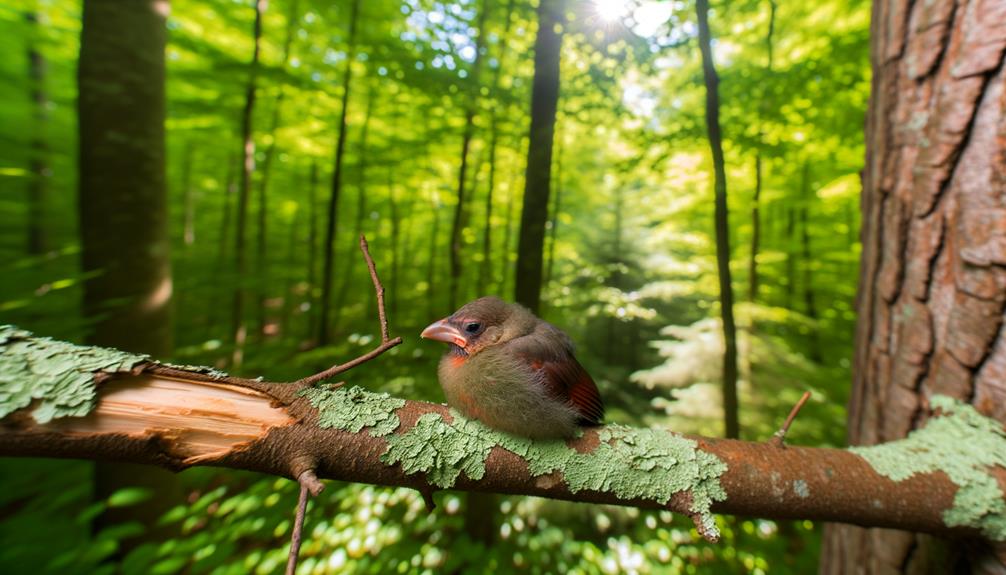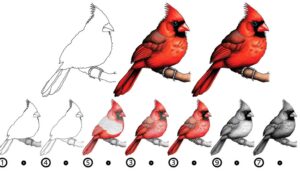Does Juvenile Cardinal Beak Color Change?
Yes, a juvenile cardinal's beak changes hue as it matures. Initially, juvenile cardinals have pale, less saturated beaks.
Genetic traits establish potential coloration, but hormones like testosterone and estrogen play an important role in pigment deposition. Diet, particularly carotenoid intake, greatly impacts color intensity, with a nutrient-rich diet leading to more vibrant hues.
Environmental factors such as sunlight and seasonal variations further influence this change. As juveniles progress to adulthood, their beaks typically change from a brownish hue to a vibrant orange-red.
Understanding these intricate factors offers deeper insights into avian development and physiology.

Key Takeaways
- Juvenile cardinal beaks transition from pale brownish hues to vibrant orange-red as they mature.
- The beak color change is regulated by hormonal shifts, particularly testosterone and estrogen.
- Carotenoid intake from diet significantly influences the intensity and hue of the beak color.
- Seasonal variations, including photoperiod and temperature, affect the timing and rate of beak color changes.
- Hormonal fluctuations and environmental factors synchronize to prompt beak color changes essential for mating displays and identification.
Cardinal Life Cycle Overview
The life cycle of the Northern Cardinal (Cardinalis cardinalis) begins with the laying of eggs, which typically occurs in a carefully constructed nest built by the female in dense shrubbery or trees.
The incubation period lasts approximately 11 to 13 days, during which the female remains on the nest, while the male provides food.
Upon hatching, the altricial chicks are entirely dependent on their parents for nourishment and protection. Both parents participate in feeding the young, which primarily involves regurgitated insects and seeds.
The fledging period spans about 9 to 11 days, after which the juveniles leave the nest but remain close by as they continue to receive parental care.
This attentive rearing guarantees the survival and eventual independence of the fledglings.
Identifying Juvenile Cardinals
Identifying juvenile cardinals necessitates careful observation of several morphological characteristics. Key indicators include the plumage and markings, which are typically less vibrant and more mottled compared to adults, as well as variations in beak shape and size that distinguish them from mature counterparts.
These attributes provide critical information for accurately distinguishing juvenile cardinals within their natural habitat.
Plumage and Markings
Distinguishing juvenile cardinals from adults involves observing specific changes in plumage and markings. Particularly, the shift from a brownish, streaked appearance to the vibrant red or rich tan hues characteristic of mature cardinals.
Juvenile cardinals exhibit a more subdued coloration, with feathers primarily brown and streaked with darker tones, aiding in camouflage. As they mature, males develop the iconic bright red plumage, while females shift to a tan or light brown hue with subtle red accents on the wings, tail, and crest.
Additionally, juveniles possess a less defined facial mask compared to adults. These changes in plumage and markings are pivotal for accurately identifying cardinals at different life stages, providing insights into their development and maturation.
Beak Shape and Size
Juvenile cardinals exhibit a distinct beak shape and size that differentiates them from adult counterparts, characterized by a shorter and more conical structure. This morphological trait facilitates their identification in the field.
The juveniles' beaks, while smaller, are robust and optimized for feeding on seeds and insects, essential for their growth and development. As they mature, the beak elongates and gradually adopts the more pronounced, slightly curved form seen in adults. This transformation is not merely cosmetic but also functional, adapting to the dietary and ecological demands of adult cardinals.
Observing these physical changes provides invaluable insights into the developmental stages of cardinals, aiding ornithologists and bird enthusiasts in distinguishing age classes within populations.
Characteristics of Juvenile Beaks
The beaks of young cardinals show a distinct morphological profile characterized by a mainly dark coloration, which gradually shifts to the vibrant orange-red hue seen in adult birds. This initial dark hue is typically a combination of brown and black pigments.
Juvenile beaks also exhibit a smoother texture and less pronounced curvature compared to their adult counterparts. The darker coloration serves as a camouflage mechanism, reducing visibility to predators.
As the cardinal matures, the beak undergoes a series of pigment changes due to metabolic processes, reflecting its progression towards adulthood.
Additionally, juvenile cardinals' beaks are relatively softer, facilitating easier feeding on the softer seeds and insects that comprise their diet during this early developmental stage.
Factors Influencing Beak Color
As the beak color of juvenile cardinals evolves, several biological and environmental factors play a significant role in this transformation. The interplay of these factors guarantees the gradual shift from the initial, less vibrant hues to the characteristic bright orange-red seen in adults.
Key influences include:
- Genetic Factors: Inherited traits dictate the baseline potential for beak coloration, determining the range within which environmental factors can exert their influence.
- Hormonal Changes: Hormones, particularly during the molting and maturation phases, regulate pigment deposition in the beak.
- Environmental Conditions: Exposure to sunlight and climatic conditions can affect the intensity and rate of color change, as ultraviolet light can enhance pigment synthesis.
Understanding these factors provides insight into the complex mechanisms underlying beak color transformation in juvenile cardinals.
Nutritional Impact on Beak Color
Dietary intake plays a significant role in the pigmentation of juvenile cardinal beaks, influencing the availability of carotenoids necessary for vibrant coloration.
Carotenoids, obtained through the consumption of carotenoid-rich foods such as fruits and seeds, are integral to the development of bright red and orange hues in cardinal beaks. These pigments are metabolized and deposited in the keratin structure of the beak, directly impacting its color intensity.
Variations in diet, particularly during developmental stages, can lead to noticeable differences in beak pigmentation. A diet deficient in carotenoids may result in duller beak colors, indicating the important link between nutrition and physical attributes.
Therefore, ensuring an adequate intake of carotenoids is crucial for optimal beak coloration in juvenile cardinals.
Seasonal Changes and Beak Color
Seasonal variations greatly influence the pigmentation of juvenile cardinal beaks, with changes in environmental factors and physiological cycles contributing to shifts in color intensity and hue.
These changes are mainly observed due to variations in:
- Photoperiod: Longer daylight hours during spring and summer can enhance pigment production, leading to brighter beak colors.
- Temperature: Warmer temperatures often correlate with increased metabolic rates, potentially affecting the synthesis of carotenoids responsible for beak coloration.
- Dietary Changes: Seasonal availability of different foods can alter the intake of pigments like carotenoids, impacting beak color.
Understanding these seasonal effects is essential for ornithologists and bird enthusiasts alike, providing insights into the adaptive mechanisms cardinals employ to thrive in fluctuating environments. This knowledge aids in comprehending broader ecological and evolutionary dynamics.
Hormonal Influence on Beak Color
The hormonal regulation of beak pigmentation in juvenile cardinals presents a complex interplay between endocrine signals and environmental factors.
Seasonal variations in hormone levels, particularly during molting periods, greatly influence the intensity and hue of beak coloration.
Understanding these hormonal mechanisms is important for elucidating the adaptive significance of color changes in avian species.
Hormones and Beak Pigmentation
Hormonal regulation plays a vital role in the pigmentation process of juvenile cardinal beaks, influencing the shift from their initial coloration to their mature hues. Specifically, the interplay of hormones such as testosterone and estrogen modulates melanin and carotenoid deposition, which are essential pigments responsible for beak coloration.
Key hormonal influences include:
- Testosterone: Enhances the deposition of carotenoids, leading to the vibrant red and orange hues observed in mature cardinals.
- Estrogen: Influences melanin production, contributing to the darker pigmentation in certain areas of the beak.
- Thyroxine: Impacts overall metabolic processes, indirectly affecting the synthesis and distribution of pigments.
Understanding these hormonal mechanisms provides insight into the complex biological processes underlying avian pigmentation.
Seasonal Color Variations
As juvenile cardinals mature, their beak coloration undergoes seasonal variations, driven by fluctuations in hormonal levels that influence pigment deposition.
During the breeding season, elevated levels of testosterone and estrogen stimulate the production of carotenoid-based pigments, resulting in more vibrant beak colors.
Conversely, in non-breeding seasons, reduced hormonal activity leads to a fading or dulling of beak coloration.
This cyclical pattern is essential for mating displays and territorial behaviors, serving as visual cues for fitness and reproductive readiness.
Studies indicate that these hormonal shifts are also influenced by environmental factors such as photoperiod and temperature, which synchronize beak color changes with best breeding times.
Understanding these mechanisms provides deeper insights into avian physiology and ecological adaptation.
Comparing Juvenile and Adult Beaks
Juvenile cardinals exhibit a distinct beak coloration compared to adults. They typically display a lighter, more muted hue that gradually changes to the vibrant orange-red characteristic of mature individuals. This transformation is an important indicator of age and development in cardinal populations.
Juvenile beaks are generally brownish or grayish, reflecting their incomplete development and lower carotenoid levels, which are pigments responsible for vivid coloration.
Key differences include:
- Color Intensity: Juveniles show a pale, less saturated beak color, whereas adults exhibit a bright orange-red hue.
- Texture and Structure: Juvenile beaks are often softer and less robust than the hardened beaks of adults.
- Functionality: Adult beaks are better suited for feeding efficiency due to their fully developed structure.
This coloration change is vital for species identification and behavior studies.
Scientific Studies on Beak Color
Numerous scientific studies have investigated the underlying mechanisms and factors influencing the beak color change in juvenile cardinals, shedding light on the physiological and environmental determinants involved in this developmental process.
Researchers have identified that hormonal changes, particularly the increase in androgen levels, play a pivotal role in evolving beak pigmentation from brownish hues in juveniles to vibrant orange-red in adults.
Additionally, diet has been noted as a significant factor; carotenoid intake from food sources directly impacts the intensity and hue of the beak color.
Environmental variables, such as habitat and exposure to sunlight, further shape this coloration process.
These studies collectively enhance our understanding of the multifaceted influences driving beak color transformation in juvenile cardinals.
Observation Tips for Birdwatchers
To accurately identify juvenile cardinals, birdwatchers should pay close attention to the distinct coloration of the beak, which shifts from a dark to a light orange.
Observers must also consider seasonal changes in plumage, as juveniles exhibit more muted feather colors compared to adults.
Documenting these characteristics can provide valuable insights into the age and development stages of cardinals.
Identifying Juvenile Cardinals
Distinguishing juvenile cardinals from adults involves closely observing their beak color, as young cardinals typically exhibit a darker, more dusky shade compared to the bright orange-red beak of mature individuals. This beak color difference is an important identification marker, especially when plumage similarities can cause confusion.
To accurately identify juvenile cardinals, birdwatchers should consider:
- Beak Shade: Juvenile cardinals have a brownish-black beak that gradually shifts to the vibrant hue seen in adults.
- Behavior: Juveniles often display more erratic and dependent behaviors, frequently seen begging from adult birds.
- Size and Shape: Juveniles may appear slightly smaller and less robust, with softer, less defined feathering than their adult counterparts.
These observation tips can greatly enhance accuracy in identifying juvenile cardinals.
Seasonal Changes in Plumage
In addition to beak color, birdwatchers should also pay close attention to seasonal changes in plumage, as these alterations can provide further insight into identifying and understanding juvenile cardinals.
Juvenile cardinals exhibit a range of plumage changes as they mature, often evolving from a brownish, streaked appearance to the vibrant red seen in adults. These transformations typically occur over several molts, with the first significant molt happening in late summer to early fall. Observing the timing and extent of these changes can assist in distinguishing juveniles from adults.
Additionally, noting the subtle variations in feather coloration, such as the gradual emergence of red feathers, can be pivotal for accurate identification and understanding of developmental stages in juvenile cardinals.
Implications for Cardinal Health
The changing beak color in juvenile cardinals is a crucial indicator of their overall health and nutritional status. As these birds mature, their beak color shift from brown to bright orange-red signifies several physiological developments.
A consistent and healthy color change can reveal:
- Nutritional Sufficiency: Adequate intake of carotenoids, essential nutrients derived from their diet, is essential for this transformation.
- Immune Function: Vibrant coloration often correlates with a robust immune system, indicating the bird's ability to fend off infections.
- Developmental Progress: Proper beak color change corresponds with normal growth and maturation processes, reflecting ideal hormonal and metabolic activity.
Monitoring these color changes can provide ornithologists valuable insights into the health and well-being of juvenile cardinals.
Conclusion
The evolution of a juvenile cardinal's beak color, set against the vibrant adult beak, emphasizes the dynamic nature of avian development.
Factors such as nutrition and environmental influences play essential roles in this metamorphosis.
Scientific studies elucidate the physiological mechanisms behind these changes, providing deeper insights into avian biology.
Observing these transformations offers birdwatchers a vivid tableau of nature's intricacies.
Understanding beak color variation not only enhances species identification but also serves as an important indicator of cardinal health.






